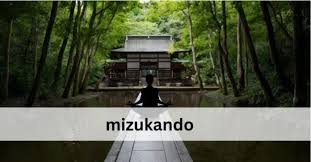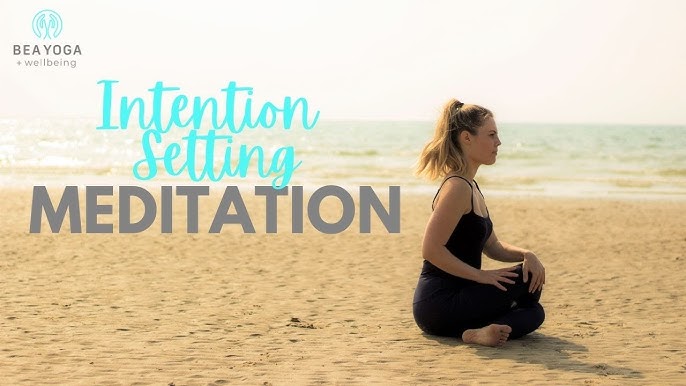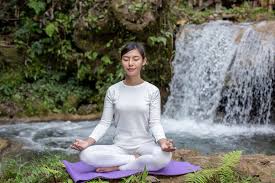Water is indeed the elixir that soothes our senses. Mizukando, or rather a water meditation, utilizes this fascinating aspect of water as one of its forms of meditation.
Consider that during this period, we might be seated beside a stream or the edge of a lake, trying to be as lost in thought as possible.
It is an age-old art that requires you to return to nature and replenish tranquillity within yourself.
This article will draw your attention to the intriguing significance of this practice, its various advantages, and practical recommendations on how to use it daily
.
If you are in quest of physical relaxation, emotional equilibrium, or soul elevation, then water meditation is an experience worth trying for every individual.
So, let us dig deeper into this refreshing practice!
What is Mizukando?

Mizukando, as the name suggests, is a meditation on water. It is a compound term of mizu (water) in Japanese and kando (to meditate) or kaido (to contemplate).
This practice encourages individuals to take an active role in their environment, placing water at the center because of its tranquil effects.
.
Mizukando, unlike other meditation techniques, which may be silent and still, accepts the movement of water while letting go.
These aid attention, be it the wave sound at the shores or gently flowing water.
Participants are usually carried off into an experience enabling them to think and feel attended to in the natural flow of activities.
The aim is to find tranquility and understand how one can experience oneself through the water.
The History and Origins of Water Meditation
Water meditation originates from times long ago.
In ancient times, people became aware of water’s soothing properties and its ability to cleanse the body and soul.
In Japan, Mizukando arose as a practice associated with Shinto features.
Water was considered a holy power, indispensable for purification and renewal.
Monks usually meditate by rivers or lakes to feel nature more deeply.
This idea was echoed by other cultures all over the world.
Water ceremonies conducted by the native people were a spiritual practice that helped them achieve inner balance.
These developments took place over time, but some main ideas persisted—communication, attention, and healing.
Nowadays, practitioners of these techniques set their energy, striving to learn forgotten knowledge from present-day lives further down the road in sessions of sitting close to the water for “Mizukando.”
The water bends rather than breaks – such a rhythm of life in each bubble. An excellent reason for a brief pause when everything is spinning out of control!
The Benefits of Mizukando:

Mizukando is one of the few that provides a combined advantage. People can immerse themselves in water, boost their blood circulation, de-stress their tired muscles, and become more flexible.
The calming atmosphere also helps the body to heal while at rest.
From an emotional standpoint, it provides water meditation to help people calm down.
Natural water has the best sound, which is very soothing. During these busy times, people usually discover peace and understanding.
On a different note, Mizukando facilitates a link with water, which is a natural source.
Religion teaches that water is a means of cleanness and renewal, so it is a useful tool in one’s spiritual quest.
Practicing this helps me learn to concentrate and become more attentive.
Water meditation instills a sense of calm that balances any other aspiration one may have in the pursuit of perfection in a messy world.
– Physical Benefits
The practice offers a variety of physiological advantages that can improve your well-being.
Using water in meditation promotes its ability to lower stress levels, which decreases stress hormones and relaxes muscles.
Once you step into the comfort covered by a blanket, your body has stored the energy required to warm yourself and move out.
It may help maintain good circulation and oxygen flow in the body.
The soft water sounds also help reduce heart and blood pressure levels. With every single deep breath, you provide rhythmic movement of the body, brain, and breath.
But still enjoying the practice of Mizukando goes a step further in observing the body states.
Equipped with such presence, it becomes easy to know what the body requires, stretch, or experience how it feels at the moment.
Increased practice may increase the range of motion, as people usually perform gentle movements at the water’s edge or in water meditations.
– Mental and Emotional Benefits
Mizukando Healing Center bridges the mental and emotional gap potent enough to change your everyday life.
Practicing meditation with water provides such a sense of calm that stress melts away, much like water erased by ripples on the surface.
In such a tranquil setting, it is easy to forget the thoughts so that thoughts can be brought back into focus.
Many practitioners are surprised to find that an increase in creativity or concentration usually marks their next sessions.
Water is a powerful thought carrier for all frantic ideas.
Fourth, Mizukando manages to touch upon the deeper emotions. It allows emotions that have been pushed or neglected to surface.
This facilitates accepting of oneself more.
Many practice, and upon observing the feedback statistics, they note that the symptoms of anxiety and depression GAD are manageable for some.
Flowing with water’s movement helps people discover a sense of flexibility and accept the change process instead of resisting it.
This extraordinary meditation cultivates both the brain and the heart regarding human needs to be in equilibrium in this age of continuous pressures.
– Spiritual Benefits
Mizukando offers all the spiritual benefits that can annualize one’s bond with the universe. Water meditation encourages practitioners to submerge themselves physically and, more so, spiritually.
Naturally, flowing water concentrates attention on the sound levels, helping people seek their inner serenity.
This mesmerizing inward journey creates awareness and oneness with the earth.
Practically, by doing Mizukando, many feel thankful and at inner peace. This enables a conducive atmosphere that is much desired for development.
Furthermore, the activity is also said to develop a clarion vision. The quietness stimulates the mind into silence, making it possible to hear whispers.
Participants frequently report transformative experiences during their sessions.
These moments contribute significantly to personal development and enlightenment on one’s life path.
How to Practice Mizukando:
To practice Mizukando, choose a site with a water body away from disturbances. This may be a quite relaxing pond, a streaming river, or even your bathtub.
The point is to be comfortable with the environment.
The next step is to form an intention, belief, or target for your meditation practice. This may be clarity, emotional possession, or simply harmony with the natural order.
Now that you have settled into your space, let your awareness be drawn to the sound and play of the water around you.
You can shut your eyes and start breathing patterns. As you exhale, imagine all the burden withdrawing with your breath.
You can use mindful techniques like listening, focusing on the action of water on the surfaces, or applying dim visualization, which can calm nerves and help with concentration.
In such an open posture, be mindful not to try to stay at the end of the session.
That is, witness whatever comes out and whatever feelings arise during that experience without any aversion.
– Finding a Quiet Place with Water
The location for Mizukando should be selected very carefully. Look for a peaceful location with running water and still water. A calm pond, the flow of a subtle stream, or even your bathtub can serve this purpose.
We all know how nature heals the mind and spirit. Water can be an instrument that fosters peace during deep rest. Pay attention to its reach against the boulders or the shore foreland and how it runs.
If you prefer to stay indoors, consider soothing sounds of water through applications or recordings to induce ease.
Such devices can help set the ambiance and create a natural environment.
Pick a place that feels secure and assures you. Your comfort will amplify the experience, encouraging a more focused and deeper exploration into the practice.
Once you have located that peaceful sanctuary, sit comfortably and perform M. Let the flow of Nature take you to evoke your desires.
Mindfulness.
– Setting an Intention or Goal for the Meditation

Setting an intention is an important step when practicing Mizukando – that’s very powerful.
It is as if you are carrying a guide that will put you on the right framework and level of understanding that you will need during meditation.
To begin with, think of the specific thing you want to accomplish.
You may wish to find tranquility, move on from your past, or create something new.
Nevertheless, it should be something that you are passionate about.
You may write it down or even picture it in your mind. After you have your intention, say it clearly with everything you have.
That makes for a more personal approach to practicing.
As you regard the water, begin to focus on this intention. Imagine the warmth of the water as it surrounds your body, and also attempt to feel the power of the intention.
This reminds us that people can have different intentions. Throughout each Mizukando session, be receptive to the possibility of new discoveries or experiences.
– Techniques and Tips for Successful Mizukando Meditation
To enjoy warming Mizukando meditation exercises, let’s start with the surroundings. Look for a quiet place to sit by the water, whether a river, lake, or fountain. The presence of flowing water is encouraging.
After that, bring in some oxygen. You can inhale using your nose and exhale using your mouth.. This pattern encourages relaxation and concentration.
Setting an intention for the meditation is essential before you commence. Whether you are seeking clarity or reducing stress, purpose enhances practice.
During meditation, picture water in motion. Try to see it as washing away the wrongs while you breathe in calmness and tranquility.
Take your time. Each moment can be difficult to accept at times but do not refrain from being attentive. Let the emotions flow; they are part of your road toward developing a sense of stillness and awareness.
Comparing Mizukando to Other Forms of Meditation
Mizukando is one of the meditation practices that truly differs from the rest.
Zen practices characteristically pay attention to a practitioner’s breath or body; Mizukando practices actively use water as the main element.
Such dispersion of attention may give more pleasure.
Although it is possible to find many practices with the movement of the mind as a central aspect, Mizukando seeks contact with water.
This gentle movement lets one let go of the tensions and express feelings more easily.
Various techniques of this sort may demand great silence and isolation; rather, Mizukando calls people to be surrounded by sound waves, and the ripples and waves become the mind’s resting music.
Furthermore, while other techniques may be very specific regarding postures or the setting, Mizukando is the most free.
A small water fountain can help you engage in this practice at the riverbank or even in the living room.
Its ease of use will allow every individual who seeks peace of mind in nature to do so.
.
Incorporating Mizukando into Daily
Integrating mizukando into any lifestyle is truly empowering. You can begin by taking just a few minutes daily to enjoy water with a lake or a river or even indulge in a bathtub.
In the morning, you can meditate in water as you start your day. While washing your face, showering, or performing any other activity that involves water, pay attention to the cascade of water as you let it flow over you.
This activity alone is enough to help center you and prepare your mind for the rest of the day’s activities.
During lunch hours or after office hours, seek out opportunities to sit beside water quite often. Allow yourself to soak in the beauty of the water body and uplift yourself.
You can also introduce aspects of mizukando while doing yoga or tai chi by practicing these exercises alongside a body of water. The water element makes each pose more focused and relaxing.
Make these activities a habit, as they will help you in the long run to make positive modifications in different sections of your life.
CONCLUSION
Integrating mizukando into your lifestyle can be a life-changing experience.
Let’s start slowly. For example, allow yourself just a few minutes each day to touch a body of water, even if it is just a tub, a lake, or a river.
If you are concerned there is no time for water consciousness practices, become your coach.
Try starting your morning rituals, for example, with a short session of water empowerment exercise.
Practice awareness of water while washing the face or taking a shower; limit your thoughts to how the water flows over the body.
This will help anchor the mood and prepare the mind to face what plans it needs to accomplish that day.
At lunchtime, after work, and any time during the day, spare a few moments to sit or stand near water. Baulk your mind and bring its energy back to the center.
While you may decide to include similar elements of the practices of mizukando within activities like yoga or tai chi, it will be wise to do this at water bodies.
This natural element is present in every pose and promotes increased focus and relaxation.
Perform these practices regularly to attain the effects that go beyond the surface.
FAQs:
What is Mizukando?
Mizukando is a meditation practice using water to promote relaxation and clarity.
Can Mizukando help with emotional balance?
Yes, it calms the mind and reduces anxiety.
What are the spiritual benefits of Mizukando?
It fosters inner peace and a deeper connection with nature.
Where should I practice Mizukando?
Ideal places include quiet ponds, streams, or bathtubs.
What should I do before practicing Mizukando?
Set a clear intention for your meditation.
What techniques enhance Mizukando?
Focus on water sounds, mindful breathing, and visualization.
Is Mizukando good for beginners?
It’s suitable for beginners and can be practiced with any body of water.

